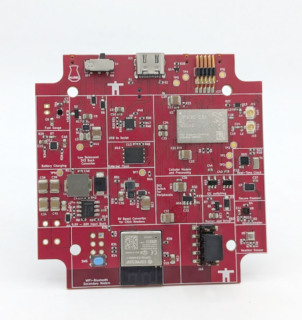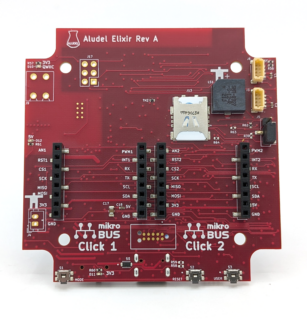An Internet of Things (IoT) device is a special snowflake of a device (seasonal reference, happy holidays!). It has many more requirements than a piece of hardware that doesn’t connect to the internet. In this post (and the video above), we talk through pitfalls when manufacturing a new piece of electronics. One topic that is particularly important in the IoT space is the provisioning process once a piece of hardware has been manufactured. As it so happens, this is a strength of Macrofab and Golioth working together.
What is Macrofab?
Macrofab is an online service that helps engineers manufacture electronics without the normal back-and-forth with traditional Contract Manufacturers (CMs). They are a web layer on top of two different resources:
- Their own in-house manufacturing, based out of Houston
- A range of different CMs, of increasing size and capabilities as you scale
As you decide to build more and more devices, your assembly will be built by larger and larger manufacturing outlets, without any interruption to the workflow that you’re used to. One benefit that I like, and one discussed in the video, is the ability to view different price breaks on an assembled board. Entering different numbers of desired assemblies will trigger recalculation of the end price and lead times:

Macrofab prices out parts and take things into consideration such as the price break of individual components, as well as targeting different scale manufacturing capabilities (again, all invisible to the user). They have calculated the “per part” cost of attaching the part to a board as well—an 0603 resistor costs less per part than a more complex BGA component which costs less than a hand-soldered connector.
I spoke with Brenden Duncombe, who is the Director of Customer Engineering at MacroFab. On any given day you might find him working with a customer on test fixtures, or helping to improve Macrofab capabilities to make a more seamless hardware ordering experience.
What we are building
 You can see an early look at the Aludel Elixir in the video (please note this is Rev A and subject to change…including soldermask color!), but we’re creating a test platform for our reference designs. The Elixir’s predecessor, the Aludel Mini, is featured in many Golioth Reference Design videos and project pages, but it is a combination of different off-the shelf development boards that requires a lot of hand soldering. We wanted something that can be produced in higher volume, as well as including additional hardware that isn’t present on some of the off-the-shelf boards that are available (including extra GPIOs).
You can see an early look at the Aludel Elixir in the video (please note this is Rev A and subject to change…including soldermask color!), but we’re creating a test platform for our reference designs. The Elixir’s predecessor, the Aludel Mini, is featured in many Golioth Reference Design videos and project pages, but it is a combination of different off-the shelf development boards that requires a lot of hand soldering. We wanted something that can be produced in higher volume, as well as including additional hardware that isn’t present on some of the off-the-shelf boards that are available (including extra GPIOs).
 One benefit for you, the reader, is we will be showcasing a more holistic picture of what it looks like to build an IoT device for production. We still employ Mikroelectronica Click boards to tap into the flexibility of that ecosystem. But more sensors are included “by default” on this board to increase capabilities. We still provide multiple build targets in our reference design repositories, in order to allow people to use entirely off-the-shelf hardware in their own evaluation. We call this “Follow Along Hardware“.
One benefit for you, the reader, is we will be showcasing a more holistic picture of what it looks like to build an IoT device for production. We still employ Mikroelectronica Click boards to tap into the flexibility of that ecosystem. But more sensors are included “by default” on this board to increase capabilities. We still provide multiple build targets in our reference design repositories, in order to allow people to use entirely off-the-shelf hardware in their own evaluation. We call this “Follow Along Hardware“.
When it came time to build up some early prototypes, Macrofab immediately sprung to mind. I wanted to be able to get budgetary pricing and make decisions around including different parts in a dynamic fashion. I also wanted to hand over the design and feel comfortable sitting back and letting someone else do the work.
Special considerations with IoT
When your electronics assembly rolls off the line and passes all tests…then what? For many test devices we work on at Golioth offices, the next step is to program in a PSK-ID and PSK. That’s an easy way to provision a new device. Also an easy way to re-provision/change things later, which is great in the prototyping stage. Once you get to production, your requirements change. Sure, you get security by default with Golioth, but you also get efficiency and hands-off provisioning onto the Golioth cloud. That’s where certificates come into play. Programming certificates into your brand new devices allows the device to present credentials the first time it connects to Golioth and a new record is created for that device.
Future Testing and BEOL
The “back end of line” (BEOL) testing is something engineers don’t think about unless they are deep into production, but could benefit from some early planning. One thing that Brenden brought up many times was the importance of creating a test fixture from the early days of a prototype. This includes having copious test points and programming pins on your PCB. This is a step that I thought I could skip because I was on my Rev A hardware. I see the value he is mentioning about reliable, standardized testing from day one. As I move into the next revision of hardware, this will be a major consideration, both for at the factory during assembly and once the boards are on my bench trying out new capabilities.
Other elements we’ll be looking into and writing about are things like serialization (adding a serial number to devices) and adding certificates onto devices being made. Golioth doesn’t sell hardware directly, but we expect to be building many more reference designs in the new year. It will make sense to follow our own advice and make a “product”, even if it’s only an internal one.
CMs that have many layers of service
We know and love many CMs in the electronics ecosystem. But we find ourselves gravitating towards the ones that have a structured approach to taking products to market and strong backgrounds in helping engineers build reliable products. We think both of these elements mesh well with Golioth’s principles. If you’re interested in building your next prototype with Macrofab, check out their online capabilities and get started today.


No comments yet! Start the discussion at forum.golioth.io